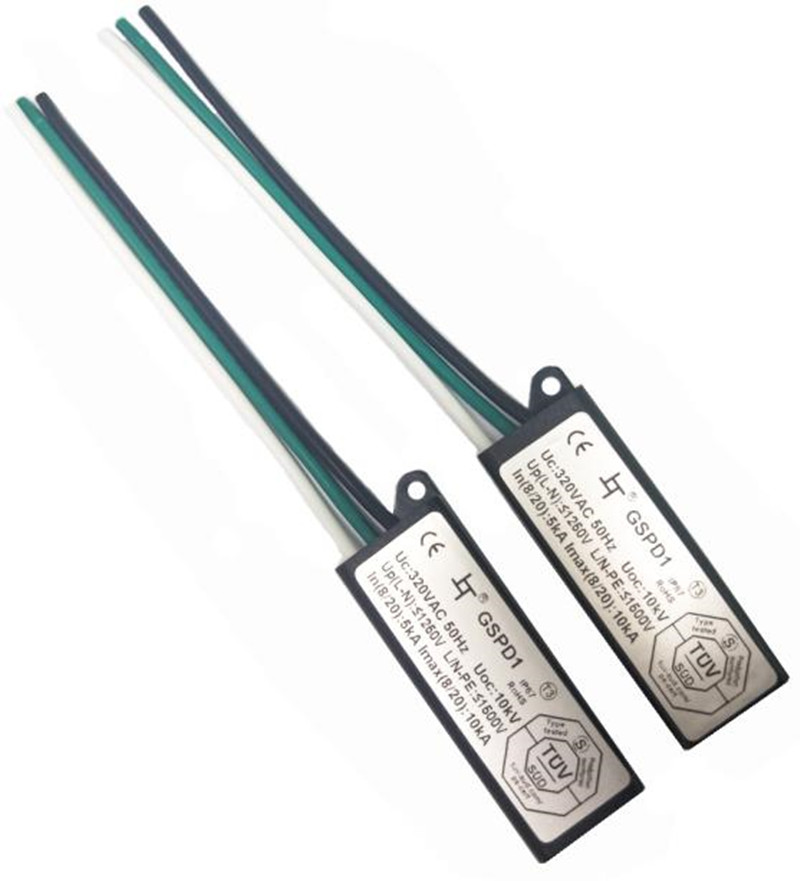Surge protection device, also known as surge protector, is an indispensable device in the lightning protection of electronic equipment. In the past, it was often referred to as "lightning arrester" or "overvoltage protector", abbreviated as SPD.
It is an electronic device that provides safety protection for various electronic devices, instruments, and communication lines. When the electrical circuit or communication line suddenly generates peak current or voltage due to external interference, the surge protector can conduct shunt in a very short time, thereby avoiding damage to other equipment in the circuit caused by surges. The function of surge protectors is to limit the instantaneous overvoltage that enters power lines and signal transmission lines to the voltage range that the equipment or system can withstand, or to discharge strong lightning currents into the ground, protecting the protected equipment or system from damage caused by impact. The type and structure of surge protective devices may vary depending on their intended use, but they should include at least one nonlinear voltage limiting element. The basic components used for surge protective devices include discharge gaps, inflatable discharge tubes, varistors, suppression diodes, and choke coils. SPD is an indispensable device in the lightning protection of electronic equipment. Its function is to limit the instantaneous overvoltage that enters power lines and signal transmission lines within the voltage range that the equipment or system can withstand, or to discharge strong lightning currents into the ground, to protect the protected equipment or system from impact.
The basic characteristics of lightning protection devices include:
1. Large protection flow rate, extremely low residual voltage, and fast response time;
2. Adopting the latest arc extinguishing technology to completely avoid fires;
3. Adopting temperature control protection circuit with built-in thermal protection;
4. Equipped with power status indicator to indicate the working status of surge protective devices;
5. Rigorous structure, stable and reliable work.
Performance characteristics
The single-phase integrated power supply lightning protection box adopts common mode and differential mode full protection modes
The single-phase integrated power supply lightning protection box adopts multi-level voltage sensitive embedded parallel technology
The single-phase integrated power supply lightning protection box adopts high flow rate, low residual voltage, and fast response time
The single-phase integrated power supply lightning protection box adopts a load overcurrent, overheating, and failure separation device
The lightning protection box for single-phase integrated power supply
Functional characteristics
The function of lightning arrester is to protect various electrical equipment in the power system from damage caused by lightning overvoltage, switching overvoltage, and power frequency transient overvoltage. The main types of lightning protection devices include protective gaps, valve type lightning protection devices, and zinc oxide lightning protection devices. The protective gap is mainly used to limit atmospheric overvoltage, and is generally used for protection of distribution systems, lines, and substation incoming sections. Valve type lightning arrester and zinc oxide lightning arrester are used for the protection of substations and power plants. They are mainly used to limit atmospheric overvoltage in 500KV and below systems, and will also be used to limit internal overvoltage or serve as backup protection for internal overvoltage in ultra-high voltage systems.
The concept of series parallel lightning protection is proposed based on the characteristics of many application scenarios and protection range hierarchy in modern lightning protection (compared to traditional parallel lightning protection devices). Its essence is the effective combination of multi-level discharge devices and filter technology through energy coordination and voltage distribution. The series parallel lightning protection has the following characteristics: widely used. Not only can it be applied according to convention, but it is also suitable for places where it is difficult to distinguish between protected areas. The voltage division and delay effect of induced decoupling devices under transient overvoltage to help achieve energy coordination. Slow down the rise rate of transient interference to achieve low residual voltage, long lifespan, and extremely fast response time.
The selection of other parameters of the lightning arrester depends on the level of the lightning protection zone where each protected object is located, and its working voltage is based on the rated voltage of all components installed in the lead circuit. The series parallel lightning arrester also needs to pay attention to its rated current.
